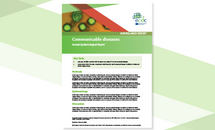Legionnaires’ disease - Annual Epidemiological Report for 2020
ECDC’s annual surveillance reports provide a wealth of epidemiological data to support decision-making at the national level. They are mainly intended for public health professionals and policymakers involved in disease prevention and control programmes.
Executive summary
- Legionnaires’ disease remains an uncommon and mainly sporadic respiratory infection with an overall notification rate of 1.9 cases per 100 000 population for the EU/EEA in 2020.
- A small decrease in the annual notification rate was observed, down from the 2.2 cases per 100 000 population reported in 2019.
- Notification rates remained heterogenous across the EU/EEA, varying from fewer than 0.5 cases per 100 000 population to 5.7 cases per 100 000 population, with the highest rate reported by Slovenia.
- Four countries (France, Germany, Italy and Spain) accounted for 72% of all notified cases.
- Males aged 65 years and older were most affected (7.1 cases per 100 000 population).
- The number of reported cases to the travel-associated surveillance scheme decreased by 67% in 2020 compared with 2019.
- Only 10% of cases were culture confirmed (10%), likely leading to underestimation of disease caused by Legionella species other than Legionella pneumophila.
Download

Legionnaires’ disease - Annual Epidemiological Report for 2020 - EN - [PDF-2.45 MB]






